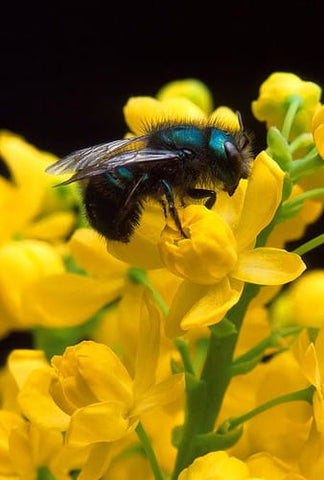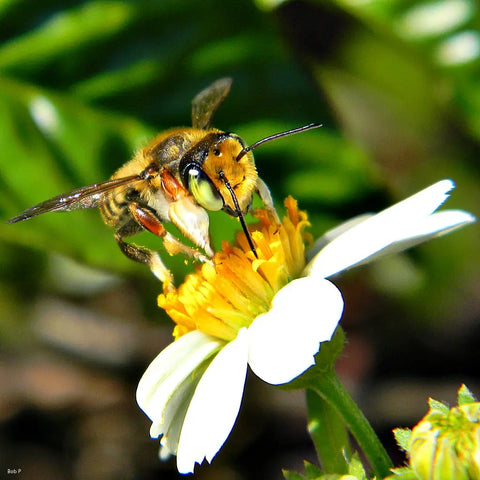We love our bees, even the ones that sting! They are remarkable creatures that play an essential role in our ecosystems, particularly in pollination. But not all bees are created equal. Honey and bumble may be the most recognizable, but there are other native bees that are just as vital and most in need of our help.
But first, what to grow for these buzzy busybodies?
Bees love a variety of flowers (just like us!); a buffet of different nectar sources is the perfect way to support these beloved pollinators. Grow Wildflowers like Clover, Aster, Monarda, and Joe Pye Weed. Or choose classics like Echinacea, Cosmos, Marigolds, Zinnias, Lupine, Foxglove, and Salvia. Most herbs are great as well, such as Oregano, Mint, Thyme, Basil, and Borage.
For a full list, click HERE
Back to bees....
Below are some of the most common bee types and a bit about what makes them unique!
The Socialites:
Honey Bees (Apis mellifera)
Honeybees are perhaps the most famous type of bee known for their large colonies, honey production and long-distance foraging. They’re the most common type of pollinator.
Technically, they are not native to North America - but neither are some of the crops they pollinate so well. Both bees and crops evolved elsewhere and were brought over by European settlers in the early 17th century (talk about codependency!).
Honeybees live in natural and domesticated environments with highly organized colonies - a queen, thousands of worker bees, and drones. They’re perennial colonies too; surviving year round with queens that can live up to several years.
Typically golden brown with black stripes, honeybees have a smoother body compared to other bees. Best of all, these bees are known for their DANCING! Honeybees perform what’s known as a ‘waggle dance’ - a series of figure eight movements made with their tail end (wag tail) to communicate the location of food sources to other members of the hive.
Bumblebees (Bombus spp.)
Bumblebees are larger, fuzzier bees with big round bottoms, hairy legs, and clear wings - from cartoons to emojis, their image is often used in illustrated versions of ‘bees’ in general.
Bumblebees live in smaller colonies, usually in underground nests, abandoned rodent burrows, or in thick grass. Some even nest in bird boxes or under garden sheds. One man’s yard waste can be a bumblebee’s mansion - it’s encouraged to leave some brush on your land whenever possible; you may never know what insects and creatures have built their habitats in your yard.
They perform something called ‘buzz pollination’, or sonication, where they vibrate the flowers with their busy buzzy hum to release pollen. Tomatoes, blueberries, eggplants, and peppers are a few examples of plants that need these bees to vibrate their hairy bodies when visiting their flowers.
Bumblebees can fly in cooler temperatures and lower light conditions than honeybees, making them effective early-morning and late-evening pollinators. Their colonies are annual which means they die off every season leaving one new queen to start a new colony in the spring.
Solitary Sorts
Carpenter Bees (Xylocopa spp.)
Carpenter bees are named for their nesting behavior, as they burrow into wood to create their nests. They’re large, robust, and can easily be mistaken for bumblebees, but with distinct differences. They have smooth, shiny, and hairless abdomens (unlike the bumble), with large mandibles on their heads used for boring into wood.
They are effective pollinators of various flowers, also performing buzz pollination, but can sometimes cause damage to wooden structures. Often found in wooden structures, trees, and deadwood, carpenter bees contribute to the natural process of decomposition and nutrient recycling. They’re generally harmless to humans - male carpenter bees can be territorial and may hover near people but are incapable of stinging, while females can sting but are usually non-aggressive and will only sting if provoked.
Mason Bees (Osmia spp.)

Mason bees are known for their efficiency in pollinating fruit trees, and their distinctive appearance and nesting habits. Similar to Carpenter bees, the mason bee female builds her own nest in pre-existing cavities. You’ll find them in hollow stems, woodpecker holes and the like, and in man-made bee houses, too. They use mud to seal their nesting chambers - hence the ‘mason’ moniker.
Mason bees are small and metallic - often bright blue or green. They are extremely effective pollinators, especially for fruit trees due to their rapid and thorough pollination methods. They’re active in early spring, visit more flowers per minute than other bee species and they land directly on the flower’s reproductive parts, ensuring a high chance of pollination.
Want to support your local Mason Bee population? Check out our Mason Bee Nest Kit!
Leafcutter Bees (Megachile spp.)
Leafcutter bees have earned their title - cutting nearly perfect circles out of leaves to line their nests. They are medium-sized, dark-colored bees, with large mandibles and generally nest in wood cavities, stems, or soil.

Leafcutters are more than just fancy decorators, they’re excellent pollinators, too. They collect pollen on the hairs of their abdomens and visit a wide variety of flowers, making for a more effective pollen transfer while they forage.
While leafcutter bees may cause cosmetic damage to some plants, this is generally minimal and does not harm the plants' overall health.
The final buzz on bees? We need them all!
There are over 20,000 species of bees worldwide and each one plays an integral role in maintaining the balance of our natural world. Unfortunately, bees face numerous threats these days including habitat loss, pesticide exposure, and disease. But every little effort helps! By growing and nurturing bee-friendly environments, minimizing the use of harmful chemicals, and championing conservation efforts, we can help ensure the survival of these crucial pollinators.
So next time you see a bee, leave ‘em bee. Our future blossoms depend on it.




